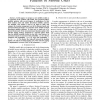Free Online Productivity Tools
i2Speak
i2Symbol
i2OCR
iTex2Img
iWeb2Print
iWeb2Shot
i2Type
iPdf2Split
iPdf2Merge
i2Bopomofo
i2Arabic
i2Style
i2Image
i2PDF
iLatex2Rtf
Sci2ools
103
Voted
EURONGI
2008
Springer
2008
Springer
Location Management Based on the Mobility Patterns of Mobile Users
In this paper, we propose a new mobility model as an extension of the random walk model. Our proposal gathers mobility patterns with several degrees of randomness, so that both random walk and totally directional mobility patterns are modeled. This model is used as an input to study and compare the location management cost of the distance-based and movement-based strategies as a function of the mobile terminal directional mobility patterns. To that end we make use of a general framework of the movement-based location update with selective paging strategy, proposed in a previous paper. Each time the mobile terminal revisits the last cell it had contact, its movement-counter is increased with probability p or it is frozen (stopped) with probability q or it is reset with probability r, (p + q + r = 1). We discuss the trade-off between the location update cost and the terminal paging cost, when selective paging is implemented, in terms of the set of parameters p, q and r.
Computer Networks | Directional Mobility Patterns | EURONGI 2008 | Mobility Patterns | Random Walk |
Related Content
| Added | 19 Oct 2010 |
| Updated | 19 Oct 2010 |
| Type | Conference |
| Year | 2008 |
| Where | EURONGI |
| Authors | Ignacio Martinez-Arrue, Pablo García-Escalle, Vicente Casares Giner |
Comments (0)

